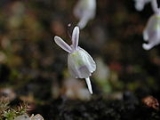
Utricularia sandersonii
Encyclopedia
Utricularia sandersonii is a small perennial
carnivorous plant
that belongs to the genus
Utricularia. It is endemic to South Africa
and is known to grow in northern KwaZulu-Natal
to Transkei
. U. sandersonii grows as a lithophyte
on wet, often vertical rocky surfaces at altitudes from 210 m (689 ft) to 1200 m (3,937 ft). It was originally described and published by Daniel Oliver
in 1865. It is a very distinct species that has entered cultivation and thrives in conditions that are easy to replicate.
since it is an invasive species
.
Perennial plant
A perennial plant or simply perennial is a plant that lives for more than two years. The term is often used to differentiate a plant from shorter lived annuals and biennials. The term is sometimes misused by commercial gardeners or horticulturalists to describe only herbaceous perennials...
carnivorous plant
Carnivorous plant
Carnivorous plants are plants that derive some or most of their nutrients from trapping and consuming animals or protozoans, typically insects and other arthropods. Carnivorous plants appear adapted to grow in places where the soil is thin or poor in nutrients, especially nitrogen, such as acidic...
that belongs to the genus
Genus
In biology, a genus is a low-level taxonomic rank used in the biological classification of living and fossil organisms, which is an example of definition by genus and differentia...
Utricularia. It is endemic to South Africa
South Africa
The Republic of South Africa is a country in southern Africa. Located at the southern tip of Africa, it is divided into nine provinces, with of coastline on the Atlantic and Indian oceans...
and is known to grow in northern KwaZulu-Natal
KwaZulu-Natal
KwaZulu-Natal is a province of South Africa. Prior to 1994, the territory now known as KwaZulu-Natal was made up of the province of Natal and the homeland of KwaZulu....
to Transkei
Transkei
The Transkei , officially the Republic of Transkei , was a Bantustan—an area set aside for members of a specific ethnicity—and nominal parliamentary democracy in the southeastern region of South Africa...
. U. sandersonii grows as a lithophyte
Lithophyte
Lithophytes are a type of plant that grows in or on rocks. Lithophytes feed off moss, nutrients in rain water, litter, and even their own dead tissue....
on wet, often vertical rocky surfaces at altitudes from 210 m (689 ft) to 1200 m (3,937 ft). It was originally described and published by Daniel Oliver
Daniel Oliver
Daniel Oliver, FRS was a British botanist.He was Librarian of the Herbarium, Royal Botanic Gardens, Kew from 1860–1890 and Keeper there from 1864–1890, and Professor of Botany at University College, London from 1861–1888....
in 1865. It is a very distinct species that has entered cultivation and thrives in conditions that are easy to replicate.
Invasive plant
U. sandersonii is listed on the New Zealand National Pest Plant AccordNational Pest Plant Accord
The National Pest Plant Accord identifies pest plants that are prohibited from sale and commercial propagation and distribution across New Zealand....
since it is an invasive species
Invasive species
"Invasive species", or invasive exotics, is a nomenclature term and categorization phrase used for flora and fauna, and for specific restoration-preservation processes in native habitats, with several definitions....
.

